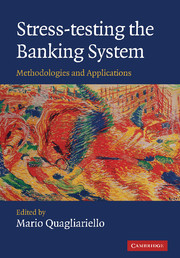Book contents
- Frontmatter
- Contents
- List of figures
- List of tables
- List of boxes
- List of contributors
- Foreword
- Acknowledgements
- Introduction
- Part I Fundamentals
- 1 A framework for assessing financial stability
- 2 Macroeconomic stress-testing: definitions and main components
- 3 Macroeconomic stress-testing banks: a survey of methodologies
- 4 Scenario design and calibration
- 5 Risk aggregation and economic capital
- 6 Data needs for stress-testing
- 7 Use of macro stress tests in policy-making
- Part II Applications
- Conclusions
- Index
- References
4 - Scenario design and calibration
from Part I - Fundamentals
Published online by Cambridge University Press: 18 December 2009
- Frontmatter
- Contents
- List of figures
- List of tables
- List of boxes
- List of contributors
- Foreword
- Acknowledgements
- Introduction
- Part I Fundamentals
- 1 A framework for assessing financial stability
- 2 Macroeconomic stress-testing: definitions and main components
- 3 Macroeconomic stress-testing banks: a survey of methodologies
- 4 Scenario design and calibration
- 5 Risk aggregation and economic capital
- 6 Data needs for stress-testing
- 7 Use of macro stress tests in policy-making
- Part II Applications
- Conclusions
- Index
- References
Summary
Introduction
In Chapter 2 identification of major risks and shock calibration in stress scenario-building has been described in the context of macro stress-testing. It has been mentioned that the choice of stress events is frequently based on a discretionary assessment of the analyst. Pros and cons of some scenario calibration approaches including historical, hypothetical and worst-off have been discussed, and the plausibility issue of a stress scenario has been raised.
In this chapter, the discussion regarding the plausibility issue will be extended in more detail, clarifying objectivity of stress-testing and introducing both practical and technical approaches for building extreme but plausible stress scenarios. The purpose of this chapter is to describe difficulties in defining what is a ‘plausible’ stress scenario, and to present a way forward to establishing objectivity in calibration.
In conducting a stress test, some degree of objectivity is required in scenario-building as well as in the design of the test, so as to have constructive discussions based on the result of the test. Extreme but plausible scenario calibration in stress-testing is critically important from that point of view. However, it seems that there is not an established measure or rationale to evaluate the plausibility of a stress scenario. The threshold of an extreme but plausible scenario seems to depend on a risk manager's judgment, for want of any established definition at the moment. From that point of view, discussions on practical solutions to plausibility issues may provide some intuition and hints for further exploration.
- Type
- Chapter
- Information
- Stress-testing the Banking SystemMethodologies and Applications, pp. 68 - 79Publisher: Cambridge University PressPrint publication year: 2009
References
- 2
- Cited by



